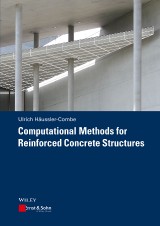Details

Computational Methods for Reinforced Concrete Structures
2. Aufl.
|
54,99 € |
|
| Publisher: | Ernst & Sohn |
| Format | EPUB |
| Published: | 23.09.2014 |
| ISBN/EAN: | 9783433603635 |
| Language: | englisch |
| Number of pages: | 354 |
DRM-protected eBook; you will need Adobe Digital Editions and an Adobe ID to read it.
Descriptions
The book covers the application of numerical methods to reinforced concrete structures. To analyze reinforced concrete structures linear elastic theories are inadequate because of cracking, bond and the nonlinear and time dependent behavior of both concrete and reinforcement. These effects have to be considered for a realistic assessment of the behavior of reinforced concrete structures with respect to ultimate limit states and serviceability limit states.<br> The book gives a compact review of finite element and other numerical methods. The key to these methods is through a proper description of material behavior. Thus, the book summarizes the essential material properties of concrete and reinforcement and their interaction through bond. These basics are applied to different structural types such as bars, beams, strut and tie models, plates, slabs and shells. This includes prestressing of structures, cracking, nonlinear stressstrain relations, creeping, shrinkage and temperature changes.<br> Appropriate methods are developed for each structural type. Large displacement and dynamic problems are treated as well as short-term quasi-static problems and long-term transient problems like creep and shrinkage. Most problems are illustrated by examples which are solved by the program package ConFem, based on the freely available Python programming language. The ConFem source code together with the problem data is available under open source rules at concrete-fem.com.<br> The author aims to demonstrate the potential and the limitations of numerical methods for simulation of reinforced concrete structures, addressing students, teachers, researchers and designing and checking engineers.<br>
1 FINITE ELEMENTS OVERVIEW<br> Modeling Basics<br> Discretization Outline<br> Elements<br> Material Behavior<br> Weak Equilibrium and Spatial Discretization<br> Numerical Integration and Solution Methods for Algebraic Systems<br> Convergence<br> <br> 2 UNIAXIAL STRUCTURAL CONCRETE BEHAVIOR<br> Scales and Short-Term Stress-Strain Behavior of Homogenized Concrete<br> Long-Term Behavior -<br> Creep and Imposed Strains<br> Reinforcing Steel Stress-Strain Behavior<br> Bond between Concrete and Reinforcing Steel<br> The Smeared Crack Model<br> The Reinforced Tension Bar<br> Tension Stiffening of Reinforced Tension Bar<br> <br> 3 STRUCTURAL BEAMS AND FRAMES<br> Cross-Sectional Behavior<br> 1 Kinematics -<br> 2 Linear Elastic Behavior -<br> 3 Cracked Reinforced Concrete Behavior -<br> 4 Compressive Zone and Internal Forces -<br> 5 Linear Concrete Compressive Behavior with Reinforcement -<br> 6 Nonlinear Behavior of Concrete and Reinforcement<br> Equilibrium of Beams<br> Finite Element Types for Plane Beams<br> 1 Basics -<br> 2 Finite Elements for the Bernoulli Beam -<br> 3 Finite Elements for the Timoshenko Beam -<br> 4 System Building and Solution Methods -<br> 5 Elementwise Integration -<br> 6 Transformation and Assemblage -<br> 7 Kinematic Boundary Conditions and Solution<br> Further Aspects of Reinforced Concrete<br> 1 Creep -<br> 2 Temperature and Shrinkage -<br> 3 Tension Stiffening -<br> 4 Shear Stiffness for Reinforced Cracked Concrete Sections<br> Prestressing<br> Large Deformations and Second-Order Analysis<br> Dynamics of Beams<br> <br> 4 STRUT-AND-TIE MODELS<br> Elastic Plate Solutions<br> Modeling<br> Solution Methods for Trusses<br> Rigid-Plastic Truss Models<br> More Application Aspects<br> <br> 5 MULTIAXIAL CONCRETE MATERIAL BEHAVIOR<br> Basics<br> 1 Continua and Scales -<br> 2 Characteristics of Concrete Behavior<br> Continuum Mechanics<br> 1 Displacements and Strains -<br> 2 Stresses and Material Laws -<br> 3 Coordinate Transformations and Principal States<br> Isotropy, Linearity, and Orthotropy<br> 1 Isotropy and Linear Elasticity -<br> 2 Orthotropy -<br> 3 Plane Stress and Strain<br> Nonlinear Material Behavior<br> 1 Tangential Stiffness -<br> 2 Principal Stress Space and Isotropic Strength -<br> 3 Strength of Concrete -<br> 4 Phenomenological Approach for the Biaxial Anisotropic Stress-Strain Behavior<br> Isotropic Plasticity<br> 1 A Framework for Multiaxial Elastoplasticity -<br> 2 Pressure-Dependent Yield Functions<br> Isotropic Damage<br> Multiaxial Crack Modeling<br> 1 Basic Concepts of Crack Modeling -<br> 2 Multiaxial Smeared Crack Model<br> The Microplane Model<br> Localization and Regularization<br> 1 Mesh Dependency -<br> 2 Regularization -<br> 3 Gradient Damage<br> General Requirements for Material Laws<br> <br> 6 PLATES<br> Lower Bound Limit Analysis<br> 1 The General Approach -<br> 2 Reinforced Concrete Contributions -<br> 3 A Design Approach<br> Crack Modeling<br> Linear Stress-Strain Relations with Cracking<br> 2D Modeling of Reinforcement and Bond<br> Embedded Reinforcement<br> <br> 7 SLABS<br> A Placement<br> Cross-Sectional Behavior<br> 1 Kinematic and Kinetic Basics -<br> 2 Linear Elastic Behavior -<br> 3 Reinforced Cracked Sections<br> Equilibrium of Slabs<br> 1 Strong Equilibrium -<br> 2 Weak Equilibrium -<br> 3 Decoupling<br> Structural Slab Elements<br> 1 Area Coordinates -<br> 2 A Triangular Kirchhoff Slab Element<br> System Building and Solution Methods<br> Lower Bound Limit Analysis<br> 1 General Approach and Principal Moments -<br> 2 Design Approach for Bending -<br> 3 Design<br> Approach for Shear<br> Kirchhof Slabs with Nonlinear Material Behavior<br> <br> 8 SHELLS<br> Approximation of Geometry and Displacements<br> Approximation of Deformations<br> Shell Stresses and Material Laws<br> System Building<br> Slabs and Beams as a Special Case<br> Locking<br> Reinforced Concrete Shells<br> 1 The Layer Model -<br> 2 Slabs as Special Case -<br> 3 The Plastic Approach<br> <br> 9 RANDOMNESS AND RELIABILITY<br> Basics of Uncertainty and Randomness<br> Failure Probability<br> Design and Safety Factors<br> <br> 10 APPENDICES<br> A Solution of Nonlinear Algebraic Equation Systems<br> B Crack Width Estimation<br> C Transformations of Coordinate Systems<br> D Regression Analysis<br> E Reliability with Multivariate Random Variables<br> F Programs and Example Data<br>
Ulrich Haussler-Combe, Prof. Dr.-Ing. habil. studied structural engineering at the Technical University Dortmund and gained his doctorate from the Karlsruhe Institute of Technology (KIT). Following ten years of construction engineering and development in computational engineering, he came back to KIT as a lecturer for computer aided design and structural dynamics. Since 2003 he has been professor of special concrete structures at Dresden University of Technology.

















